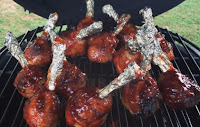 Mel surprised me this week when she bought groceries! She bought half a smoked ham. Geez, now I've got to come up with a menu for Christmas dinner. I thought to take it easy and just grill some steaks, but this changed what I had in mind. Eek!
Mel surprised me this week when she bought groceries! She bought half a smoked ham. Geez, now I've got to come up with a menu for Christmas dinner. I thought to take it easy and just grill some steaks, but this changed what I had in mind. Eek!How could I fix this mammoth sized piece of meat with no standard oven. We still haven't bought propane for the big stove. I only have three electric stove top eyes to work my magic on. It's way too big for either the microwave or toaster oven. I know. I'll use the big crockpot. If the lids doesn't close, I'll wrap it with aluminum foil. Bet Mel didn't think that through when she saw the price of the ham.
 Now the glaze. Normally, I'd stud it with some pineapple and cloves with a brown sugar and honey glaze, but Mel complained that the ham is too sweet for her tastes. I already made that mistake in the time I've been cooking for her. Yes, she can be a picky eater. I know, I'll do a honey-mustard glaze. After a quick double check of resources, yes, it would work in a crockpot too. That issue was solved. Now, onto the next issues- sides and dessert.
Now the glaze. Normally, I'd stud it with some pineapple and cloves with a brown sugar and honey glaze, but Mel complained that the ham is too sweet for her tastes. I already made that mistake in the time I've been cooking for her. Yes, she can be a picky eater. I know, I'll do a honey-mustard glaze. After a quick double check of resources, yes, it would work in a crockpot too. That issue was solved. Now, onto the next issues- sides and dessert. Hmm, what to fix...rummaging around in the freezer I found a bag of spinach. I can work with that. We have no other greens in the freezer. I really wanted my step mother's collards. But I still can't drive yet. The neurologist told me it would be at least six months without a seizure (Feb or Mar) before he'd clear me to drive again. I can make Sauteed Spinach with Mushrooms Garlic and Lemon Zest.
Hmm, what to fix...rummaging around in the freezer I found a bag of spinach. I can work with that. We have no other greens in the freezer. I really wanted my step mother's collards. But I still can't drive yet. The neurologist told me it would be at least six months without a seizure (Feb or Mar) before he'd clear me to drive again. I can make Sauteed Spinach with Mushrooms Garlic and Lemon Zest.I'm twiddling my thumb and wracking my brain for inspiration to strike on the second vegetable. For someone who requires two vegetables a meal, Mel doesn't really like a wide range of vegetables. Something different. Something special. Something we
 hadn't had in a while. I went into the food storage building and scanned the hundred odd jars of produce I'd canned. That's all I have left of the 800+ jars of fruits, vegetables, and meats I canned in 2017. Now, they all fit nicely on the top shelf of each rack. I'm getting worried about our grocery situation. I'm beginning to feel like Old Mother Hubbard when I walk into the stores building. Then, in the back corner, I spy the last jar of canned sweet potatoes. That would work. I can make whipped sweet potatoes with horseradish for a nice zing.
hadn't had in a while. I went into the food storage building and scanned the hundred odd jars of produce I'd canned. That's all I have left of the 800+ jars of fruits, vegetables, and meats I canned in 2017. Now, they all fit nicely on the top shelf of each rack. I'm getting worried about our grocery situation. I'm beginning to feel like Old Mother Hubbard when I walk into the stores building. Then, in the back corner, I spy the last jar of canned sweet potatoes. That would work. I can make whipped sweet potatoes with horseradish for a nice zing. So now, I've got a meat and two vegetables Mel's idea of a diet. Issue solved.
So now, I've got a meat and two vegetables Mel's idea of a diet. Issue solved.A bread...I could do a skillet cornbread. Nah, I just made that on Sunday. I know... I'll make my Hokkaido milk bread dough and make some Parkerhouse rolls. I can even freeze some before baking for later use. Issue solved.
 Now, something sweet for dessert besides the cookies, fudge, chocolate covered cherries, and divinity I made earlier in the week to give to our three closest neighbors. Something sweet, but not too sweet. I found a bag of raw cranberries in our little freezer. We always keep these on hand plus the dried ones up in the cabinet. I can do a cranberry bar with cream cheese frosting. We've got other really sweet things to eat if the desire strikes. Issue solved.
Now, something sweet for dessert besides the cookies, fudge, chocolate covered cherries, and divinity I made earlier in the week to give to our three closest neighbors. Something sweet, but not too sweet. I found a bag of raw cranberries in our little freezer. We always keep these on hand plus the dried ones up in the cabinet. I can do a cranberry bar with cream cheese frosting. We've got other really sweet things to eat if the desire strikes. Issue solved.So the Christmas Dinner Menu at the Cockeyed Homestead 2019 is...
Honey-Mustard Glaze
Smoked Ham
Sautéed Spinach
with Mushrooms Garlic and Lemon Zest
Mashed Sweet
Potatoes with Horseradish
Parkerhouse Rolls
with Fresh Butter
Cream Cheese
Frosted Cranberry Bars
Okay, now I feel better. That really sounds festive, doesn't it? Thanks for reading and sticking with me as I puzzled out a menu for Christmas dinner. I might even break out Mel's fine china and silver to boot. If Mel can surprise me with a ham for Christmas dinner two days before Christmas, she can at least polish the silver, can't she? No recipes today folks, I apologize. After all, it's not a regular cooking/recipe sharing day. Y'all have a Merry Christmas!
Y'all have a blessed day!
Cockeyed Jo & Mel




















